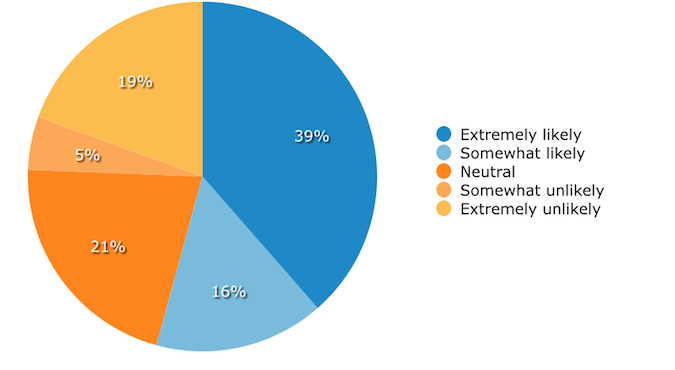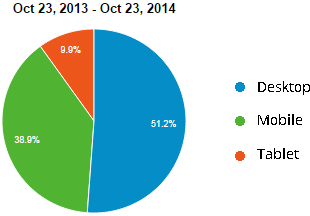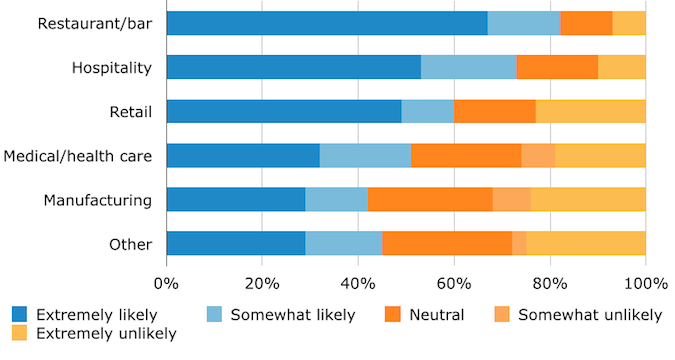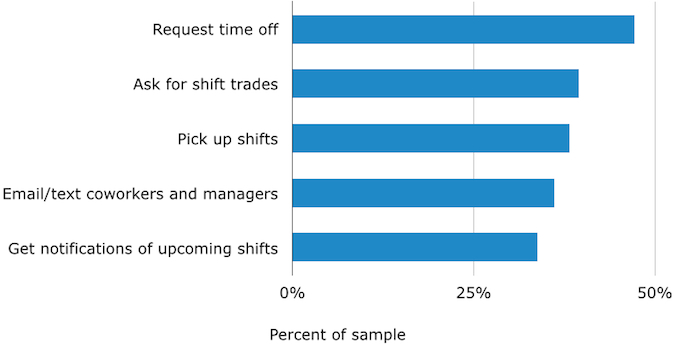Will Employees Even Use a Mobile Scheduling Application?
As mobile technology continues to revolutionize the way we receive information, employees are beginning to expect that their workplace follow suit. According to Gartner research, mobile device shipments are forecast to grow in 2015, with tablets seeing a 23 percent increase and mobile phones rising 3.8 percent (Gartner, 2014). Employers can use this channel to better engage their employees, and give them instant access to crucial information; for instance, notifying available staff of an extra shift that needs filling because an employee is absent.
A survey of hourly shift workers conducted by Software Advice, an online resource for employee scheduling software, found that 55 percent would use a mobile scheduling app if their employer offered one (Figure 1). Here at eSchedule we have witnessed similar results, with 49 percent of user sessions accessed through a mobile device over the last year (Figure 2). It’s evident that employees recognize the value in a mobile scheduling solution and those industries that are dominated by shift work can benefit from their implementation.
Figure 1 – Likelihood to Use Mobile Scheduling App

Figure 2 – eSchedule Sessions by Device

Which Industries are Going to Benefit Most?
Part-time, seasonal and auxiliary staff are responsible for a great number of manager headaches, and for many industries, their core workforce is comprised of these types of employees. Common industries that employ hourly workers include retail, health care, education, restaurants and manufacturing. Scheduling managers in these organizations must handle a greater number of shift trades, availability changes and absence requests, as these employees have other commitments. This knowledge has been the drive behind eSchedule’s continuous development of our online employee scheduling software, which aims to address the problems that these industries face.
One of the major benefits of moving your staff schedule to the cloud is that you can access the application from anywhere, anytime and with any device. Having convenient access empowers your employees to be a part of the scheduling process, rather than leaving the burden entirely on a manager. So which shift work industries have employees that recognize this and are likely to use a mobile scheduling app?
According to the survey conducted by Software Advice, more than 60 percent of employees in each the retail, hospitality and restaurant industries would be either somewhat likely or extremely likely to use a mobile scheduling application, with the restaurant industry responding overwhelmingly that 82 percent would (Figure 3).
Even though the data in Figure 3 shows that employees in the retail and medical/health care sectors are somewhat less likely to make use of a mobile scheduling app, we have observed different behavior from our customers. We find that our customers in these two industries often struggle with filling shifts last minute due to a missed shift or unexpected increase in demand and therefore rely on access to a mobile app. Managers are unable to leave the busy floor so release an open shift from their device which is in turn accepted by on-the-go employees.
Figure 3 – Likelihood to Use Mobile Scheduling App by Industry

How Can Hourly Workers Have a Flexible Schedule?
Flexible work schedules have proven to benefit the lives of workers, as both stress and burnout is lower amongst employees that engage in all forms of this arrangement (Grzywacz, Carlson & Shulkin 2008). Unfortunately in these industries comprised mainly of shift workers, arranging flexible schedules has proven difficult, with some companies even taking a “set and forget” approach to scheduling. This creates a vicious cycle as the promise of flexibility is one of the main reasons people are taking these part-time positions; they’re trying to balance other obligations like school, a second job or family (and for some superhumans, all three) and require that their employer works around this. Employers are upset when their workers can’t make the shift they’re scheduled for and workers are bitter towards employers for not being flexible with their availability.
Open-shift scheduling is a compromised solution that allows managers to schedule the hours they require to meet customer demand, but leave the shifts unfilled so that their employees can login to the application and pickup the ones they want to work. This flexibility empowers employees while still ensuring proper floor coverage. Further, if a shift needs covering at the last minute, it can be released as open and will notify all available employees that hours have become available.
Mobile scheduling is another way you can offer your employees flexibility, as they receive SMS notifications of new shifts while on-the-go, and can immediately pickup the hours they want to work. In fact, shift work industry respondents to Software Advice’s survey indicated that
Figure 4 – Preferred Employee Scheduling App Features

38 percent (Figure 4) of them would use a mobile scheduling app to pickup shifts if this feature were offered. As the norm continues to shift toward mobile devices over PCs, we only expect adoption to increase.
Providing your shift workers with more flexibility in their schedule also saves scheduling manager’s time. Not only does the process become more efficient, but employees are now responsible for selecting their shifts and in essence are building the schedule themselves. Since they choose the hours that work around their availability, there should also be a significant reduction in shift-trades and time consuming schedule edits.
Conclusion
Many shift workers enter into part-time jobs because they are looking for the flexibility that a 9-5 job doesn’t always provide. However, these employees quickly become frustrated that managers aren’t able to work around their changing availability and managers aren’t happy their workload has increased just to accommodate employee requests. We have demonstrated how an employee scheduling app, in combination with open-shift functionality, is one solution to this common problem. As the shift toward higher mobile device usage continues, it will become increasingly easy for these industries to adopt mobile scheduling with the confidence that their employees will use it and by doing so, can achieve the flexible schedule they desire.
Graphs and numerical values provided by external research done by Software Advice, online at:
http://www.softwareadvice.com/hr/industryview/employee-preferences-mobile-scheduling-2014/.





